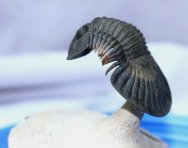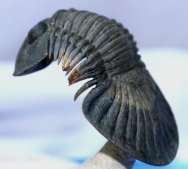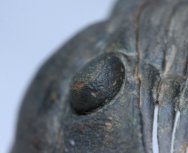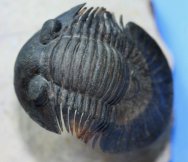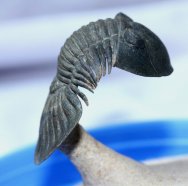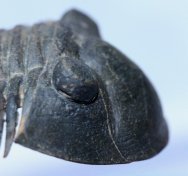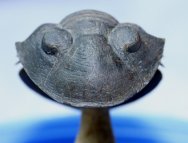Paralejurus spatuliformis
Trilobites Order Corynexochida, Family Styginidae
Geological Time: Middle Devonian
Size: Trilobite is 62 mm long
Fossil Site: Mrakib, Alnif , Morocco
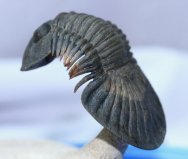 Description:
A member of the Order Corynexochida, Family Syginidae from the
Middle Devonian deposits of Alnif, Morocco, this is an ENTIRELY
NEW Scutellid-like member of the genus Paralejurus. At first glance,
it looks like a Paralejurus when only the cephalon is viewed. When
the matrix is rotated to see the pygidium, it can be seen to be
that of the typical Scutellum, but has some terracing more like
a Paralejurus. When I first saw an example at the Tucson fossil
show last year I was unsure as to its taxonomy. A well known US
collector of trilobites whose collection of specimens is only surpassed
by his collection of literature informed me recently that this
one is known as Paralejurus spatuliformis. The genus derives its
name from the spatulate pygidium which is far fifferent from the
vaulted forms of Paralejurus dormitzieri for example. It is most
closely related to the contemporaneous Paralejurus richteri of
the Czech Repulic
and younger Paralejurus galloisi from France. Since both Paralejurus
and Scutellum are members of the same family, it is not unreasonable
to expect that transitional species could occur. While the two-tone
color of the pygidium may be an artifact of preservation, I am
inclined to believe it may well reflect the natural difference
in coloration. With the advent of a reliable source of electricity
in Morocco, the quality of preparation has improved dramatically
over the past few years. While I used to refer to trilobites prepared
in a mode similar to this as flying, I feel a new term is warranted
by the preparation now coming into vogue. This one is stunning
from any aspect. Description:
A member of the Order Corynexochida, Family Syginidae from the
Middle Devonian deposits of Alnif, Morocco, this is an ENTIRELY
NEW Scutellid-like member of the genus Paralejurus. At first glance,
it looks like a Paralejurus when only the cephalon is viewed. When
the matrix is rotated to see the pygidium, it can be seen to be
that of the typical Scutellum, but has some terracing more like
a Paralejurus. When I first saw an example at the Tucson fossil
show last year I was unsure as to its taxonomy. A well known US
collector of trilobites whose collection of specimens is only surpassed
by his collection of literature informed me recently that this
one is known as Paralejurus spatuliformis. The genus derives its
name from the spatulate pygidium which is far fifferent from the
vaulted forms of Paralejurus dormitzieri for example. It is most
closely related to the contemporaneous Paralejurus richteri of
the Czech Repulic
and younger Paralejurus galloisi from France. Since both Paralejurus
and Scutellum are members of the same family, it is not unreasonable
to expect that transitional species could occur. While the two-tone
color of the pygidium may be an artifact of preservation, I am
inclined to believe it may well reflect the natural difference
in coloration. With the advent of a reliable source of electricity
in Morocco, the quality of preparation has improved dramatically
over the past few years. While I used to refer to trilobites prepared
in a mode similar to this as flying, I feel a new term is warranted
by the preparation now coming into vogue. This one is stunning
from any aspect.
Reference: Journal of Palaeontology, 78 (4) 2004, pp 709-722. Also see: Moroccan Trilobites |
